LG G2 and MSM8974 Snapdragon 800 - Mini Review
by Brian Klug on September 7, 2013 1:11 AM EST- Posted in
- Smartphones
- LG
- Mobile
- LG G2
- Android 4.2
- MSM8974
- Snapdragon 800
Display
We've been very pleased with what comes out of LG Display as of late, and the G2 doesn't disappoint. It's a 5.2-inch diagonal LCD with 1920x1080 resolution for 423 PPI density. Of course, it isn't just resolution that matters, but of course calibration, viewing angles, and other quality measures. What's interesting about the G2 is that it has two discrete touchscreen matrices which get routed to the top and bottom and out two different connectors. LG says this allows it to get the bezels on the G2 down to 2.65mm. I find a lot of what constrains device size lately is really width rather than height, and maximizing the amount of the front area used by display helps devices include bigger displays without getting too large.
![]()

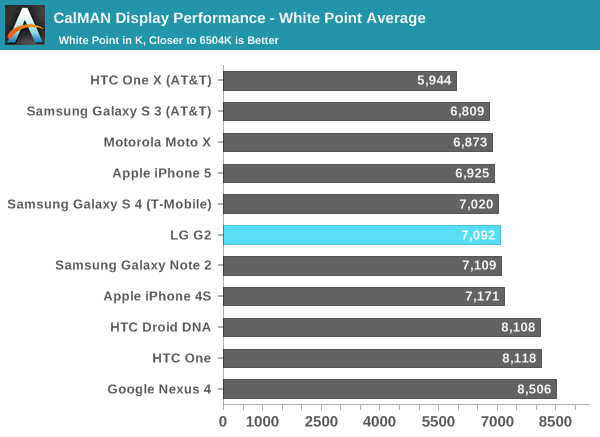
Saturations:
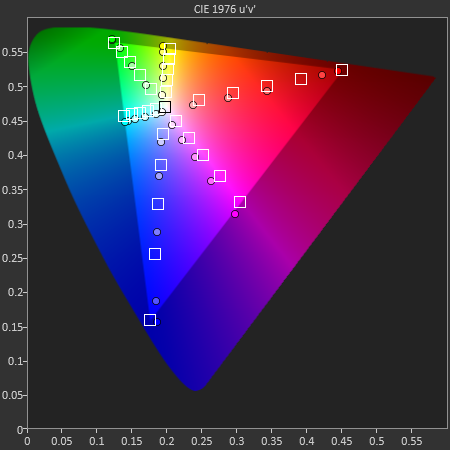

Grayscale Sweep:

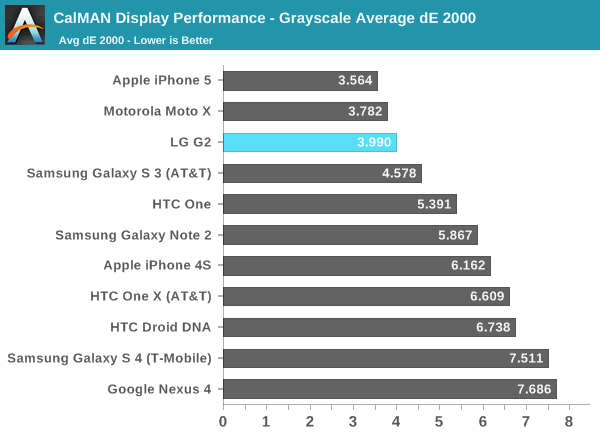
GMB Color Checker:
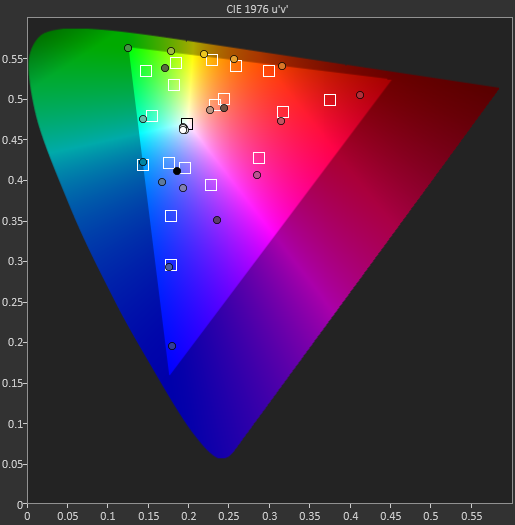
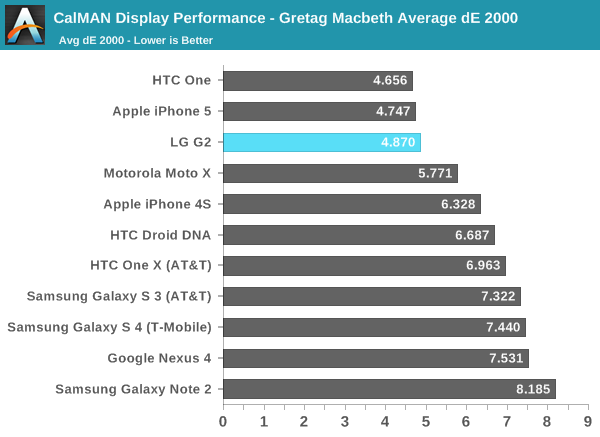
I measured the G2 display and was very impressed with how things turned out. The panel goes nice and bright (around 400 nits) but not quite as high as the 460 from the 720p LG Display panel from the Nexus 4. On the bright side however it comes in close to 6504K in temperature, and has some of the lowest DeltaE 2000 scores we've seen, with the iPhone 5, HTC One, and G2 clustering together in the GMB color checker test and saturations sweep.
















120 Comments
View All Comments
Impulses - Saturday, September 7, 2013 - link
I've got an EVO LTE but I'm on a similar boat, furthermore, this is the first tine in three years where I'm just not in a hurry to upgrade. Going to dual cores and 1GB of RAM was huge (EVO to EVO 3D), going from qHD to 720p and a much thinner device last year was also huge (not to mention ICS/JB)... Right now there's no hugely compelling hardware/software reason urging me to upgrade tho. I still might if this comes out as a Nexus 5 for $350 tho...RollingCamel - Saturday, September 7, 2013 - link
What about the audio codecs LG claimed support for? Did you try FLAC on it?maglito - Monday, September 9, 2013 - link
FLAC has native support on every 4.X android device.shackanaw - Monday, September 9, 2013 - link
He's referring to the 24-bit/192khz support and other improvements mentioned in the G2 hands on: http://www.anandtech.com/show/7205/hands-on-with-t..."LG has made audio in the line-out sense a priority for the G2. We’ve seen a lot of emphasis from other OEMs on speaker quality and stereo sound, with the G2 LG has put time into rewriting part of the ALSA stack and Android framework to support higher sampling and bit depth. The inability of the Android platform to support different sampling rates for different applications remains a big limitation for OEMs, one LG wrote around, and with the G2 up to 24 bit 192 kHz FLAC/WAV playback is supported in the stock player, and LG says it will make an API available for other apps to take advantage of this higher definition audio support to foster a better 24-bit ecosystem on Android.
"I asked about what codec the G2 uses, and it turns out this is the latest Qualcomm WCD part, which I believe is WCD9320 for the MSM8974 platform. LG says that although the previous WCD9310 device had limitations, the WCD9320 platform offers considerably better audio performance and quality that enables them to expose these higher quality modes and get good output. The entire audio chain (software, hardware codec, and headphone amplifier) have been optimized for good quality and support for these higher bit depths, I’m told. I didn’t get a chance to listen to line out audio, but hopefully in testing this emphasis will play itself out."
tuxRoller - Tuesday, September 10, 2013 - link
24bit playback is a gimmick since even the studio equipment, apparently, doesn't handle the full 24bit. Aside from that, you just don't need that much sample accuracy unless you're superman.http://xiph.org/~xiphmont/demo/neil-young.html
ssj3gohan - Saturday, September 7, 2013 - link
Why are the iPhone raw triangle/fill rate tests so much better than any other phone, yet does it perform middle of the pack in gfxbench and such? I was under the impression that they basically had the best graphics solution around, paired with awesomely optimized software.et20 - Saturday, September 7, 2013 - link
Apparently they didn't optimize for gfxbench.UpSpin - Saturday, September 7, 2013 - link
The meaningless synthetic benchmarks always favored iOS. The reason many people think that iPhones are magnitudes more powerful than Android devices.The only meaningful benchmarks are normal 3D scenes.
I don't understand why Anandtech still posts those meaningless benchmarks. Or can you read something out of them? NO! They are in no way a measurement for performance. They are basically useless. That's the reason we don't see them on desktop GPU comparisons.
tuxRoller - Saturday, September 7, 2013 - link
They give you a good idea of the device's capabilities in specific areas. Useful for doing a deep dive to determine what the make-up of the device is.For realworld use, you are absolutely right, and, imho, such synthetics only belong in articles where there are new components (like this one), but for the next snapdragon-800, I don't think those particular benchmarks need be run..
Krysto - Sunday, September 8, 2013 - link
Sunspider also seems pretty pointless at this point. Kraken and Octane seem to give more accurate results in terms of chip performance.